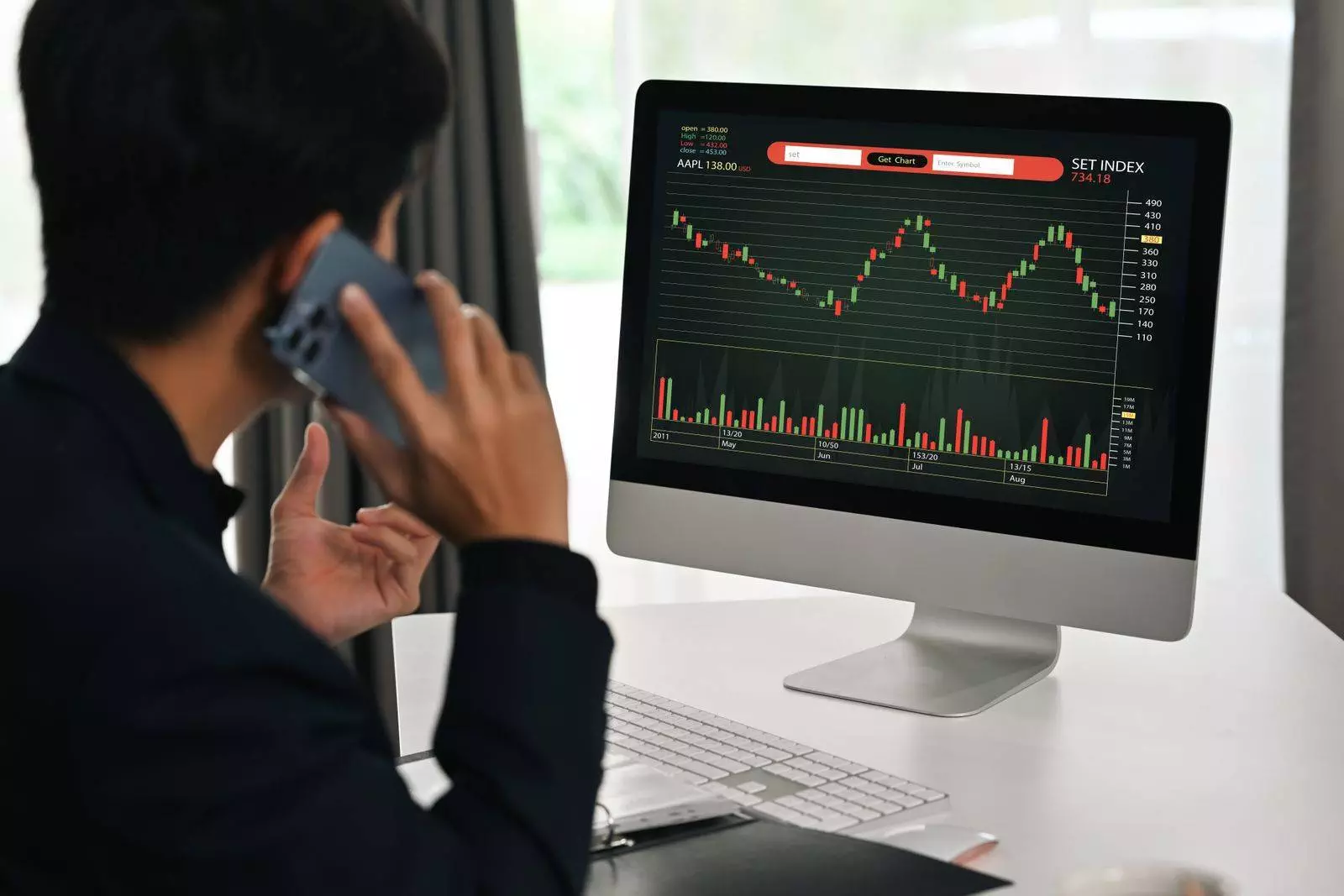As a day trader, I’ve ridden the tumultuous waves of engaging with extremely unstable stocks – navigating the heartbreaking downturns and exhilarating peaks. I’ve delighted in the rush that comes with watching a stock’s price surge, while also grappling with the profound disappointment of witnessing what seemed like a guaranteed win transform into a losing gamble.
I’ve seen my portfolio dwindle, only to soar back to impressive heights, all within the same trading day. This, my friends, is the world of high-volatility stocks where fortunes are made and lost, and where every trade can be a wild ride.
But what if I told you that the chaotic world of high-volatility stocks isn’t as terrifying as it seems? What if I told you that with the right strategy, the right attitude, and the right knowledge, you could turn this daunting realm into a playground of opportunities?
In this article, I’m going to share with you the secrets to navigating high-volatility stocks, the strategies that can help you maximize your day trading gains, and how to find the most volatile stocks that might give you the highest returns.
So buckle up, because this ride is about to get interesting.
Unraveling the Intricacies of High-Volatility Stocks in Day Trading

As a day trader, it’s crucial for me to understand the concept of stock volatility and the factors that contribute to high volatility in stock prices. Being familiar with these elements not only equips me to navigate the market’s difficulties, but also helps me make strategic decisions that can lead to significant profits.
Therefore, choosing high-volatility stocks matters to me and should matter to any day trader out there.
Understanding the Concept of Stock Volatility in Trading
While navigating the labyrinth of stock trading, you’ll often bump into the term ‘volatility’ – a polite code for the sometimes wild mood swings of the market. Understanding the concept of stock volatility in trading is like being handed a compass amidst the tumultuous sea of financial markets.
Trading high volatility stocks can be a high-stakes poker game, but one that can be rewarding. It’s no surprise that high volatility stocks for day trading often catch the eyes of day traders. But why do day traders often focus on these roller-coaster shares?
- Volatility is a measure of the frequency and magnitude of price movements. Larger swings and frequent changes hint at higher volatility.
- High volatility stocks offer the potential for significant price movements within a short time frame, creating ample trading opportunities.
- You can identify stock volatility by using statistical measures like standard deviation or by observing price fluctuations directly on a stock chart.
- Trading high volatility stocks requires a good understanding of risk management, as these stocks can move against you just as quickly as they can move in your favor.
- It’s crucial to stay updated with market news, as volatility is often driven by changes in market sentiment, economic data releases, and company-specific news.
Navigating the world of high-volatility stocks is not for the faint-hearted, but for those who dare, it can be a thrilling ride.
Now, let’s delve deeper into what triggers these dramatic price swings and uncover the factors contributing to high volatility in stock prices.
Factors Contributing to High Volatility in Stock Prices
So, you’re intrigued by the dramatic price swings in the market, right? Let’s peel back the curtain and explore the factors that fuel this roller-coaster ride.
The factors contributing to high volatility in stock prices are multifaceted and intricately woven into the fabric of the market. They range from macroeconomic indicators such as interest rates, inflation, and geopolitical tensions to microeconomic factors like company earnings, news events, and even market sentiment.
When trading high volatility stocks, these elements can cause sudden and significant price shifts, making day trading volatile stocks an adrenaline-fueled pursuit. But it’s not just about the thrill.
The price volatility on high trading days can offer a bounty of opportunities for the savvy trader who knows how to navigate these turbulent waters. It’s all part of the game for trading high volatility stocks.
Now, let’s delve deeper into why this high-stakes game of volatility is a pivotal play for day traders.
Why Choosing High-Volatility Stocks Matters for Day Traders?
Believe it or not, for those adrenaline-fueled market mavens, picking shares known for their wild price swings can make all the difference.
As a day trader, choosing high-volatility stocks can be the key to unlocking significant gains during the trading day. High volatility stocks for day trading can offer a wider range of price movements, providing more opportunities for me to make profitable trades.
These stocks are not for the faint of heart – their prices can rocket to the moon and plummet back to earth in the blink of an eye. But if you’re like me, it’s precisely this unpredictability that makes stock trading so exciting. Here’s a quick overview of why high-volatility stocks matter:
| Reason | Explanation | Impact on Day Trading |
|---|---|---|
| Larger Price Swings | High volatility stocks experience larger price movements | More opportunities for profitable trades |
| Increased Trading Volume | These stocks often have higher trading volumes | Easier to enter and exit trades |
| Potential for Quick Profits | Swift price changes can lead to quick gains | Faster turnover of capital, increasing trading volume |
| Higher Risk | Prices can drop as quickly as they rise | Risk management strategies are crucial |
| Exciting Trading Environment | Constant price changes keep things interesting | Keeps day traders engaged and alert |
The trick now is to master the art of finding the most volatile stocks for maximum day trading gains.
Finding the Most Volatile Stocks for Maximum Day Trading Gains

As a day trader, I’m always on the hunt for the most volatile stocks to maximize my potential gains. I’ve found that using tools and indicators helps to pinpoint these high-volatility stocks.
Navigating stock screeners and platforms helps in conducting a targeted search. I’ve learned to always keep an ear to the ground for any news and announcements that could significantly influence share price volatility.
Using Tools and Indicators to Pinpoint High-Volatility Stocks
Perfectly picking potential high-volatility stocks for profitable day trading demands the diligent deployment of diverse digital tools and detailed indicators.
It’s not about simply dipping your toe in the market, and hoping for the best. Oh no, we’re talking about utilizing tools and indicators to pinpoint high-volatility stocks to ensure you’re trading the most volatile stocks for maximum gains.
One such tool is a stock screener, which can help to identify stocks that are likely to be volatile.
| Tools & Indicators | Function | Importance In Day Trading |
|---|---|---|
| Stock Screener | filters stocks based on user-defined metrics | Pinpoints high volatility stocks |
| Moving Average | Indicator that smoothens price data to identify trends | Helps predict future price volatility |
| Bollinger Bands | Volatility indicator that depicts a specific standard deviation around a moving average | shows levels of market volatility |
| Relative Strength Index (RSI) | Momentum oscillator that measures speed and change of price movements | identifies overbought or oversold conditions that may precede a price swing |
Embarking on this journey of mastering the art of day trading, armed with the right tools and indicators, is not just about chasing profits.
It’s about becoming a seasoned trader who can confidently navigate the choppy waters of high-volatility stocks for day trading. Now, let’s dive deeper into the world of stock screeners and trading platforms for a targeted search.
Navigating Stock Screeners and Platforms for a Targeted Search
Having dissected the importance of utilizing tools and indicators to pinpoint high-volatility stocks, let’s now dive into the world of navigating stock screeners and platforms for a targeted search.
These online tools are a gold mine for day traders seeking high volatility stocks for day trading. With a few clicks, I can filter out the noise and generate a list of the most volatile stocks that match my risk tolerance and trading strategy. By monitoring their trading activity, I gain insights into price movements and trends, enabling me to make informed trading decisions.
However, this is only half the battle. The other half involves staying updated with the latest news and announcements that could heavily influence share price volatility. So, after using stock screeners and platforms to identify potential high-volatility stocks, my next move is to keep my finger on the pulse of the market.
Watching out for News and Announcements Influencing Share Price Volatility
In your quest to capitalize on market fluctuations, it’s crucial to stay abreast of breaking news and major announcements that could send ripples through the share prices.
As an active trader, you must be vigilant and proactive, always on the lookout for stocks today that exhibit high volatility, driven by recent trading trends and the ever-changing price action.
The financial markets are a dynamic ecosystem, and any significant news and announcements can trigger dramatic shifts, creating opportunities for day traders to pounce on and profit from share price volatility.
By being in the loop, you’re positioning yourself at the front lines, ready to ride the wave or duck for cover as the market swings.
Now, armed with this knowledge, it’s time to delve deeper and focus on crafting a solid game plan to navigate the turbulent waters of high-volatility stocks trading.
Formulating an Effective Strategy for Trading High-Volatility Stocks

As we dive into the art of trading high-volatility stocks, we’ll focus on achieving a balance between risk and potential rewards in volatile market conditions.
We’ll explore the role of diversification as a protective measure, given its importance in cushioning our portfolios against potential market downturns.
We’ll discuss the strategic use of stop-loss orders to set boundaries on potential losses, a critical tool in mitigating risk in the high-stakes world of volatile stock trading.
Balancing Risk With Potential Rewards in Volatile Market Conditions
Navigating the choppy waters of volatile market conditions, you’ll need to balance the lure of substantial rewards with the ever-present risk of significant losses. Trading high volatility stocks for day trading can indeed offer exciting opportunities, but it’s essential to manage the inherent risks wisely.
I can break the balancing act between potential rewards and risks in volatile market conditions down into the following key points:
- Understanding market volatility: The very nature of high volatility stocks means they’re subject to rapid price changes. This can create lucrative opportunities for day traders, but it also means the potential for losses is magnified. Understanding these dynamics is crucial to mitigate risk.
- Crafting a strategy: Every successful day trader has a well-thought-out strategy. When trading high volatility stocks for a day, this should include setting stop-losses to limit potential losses, using limit orders to manage entry and exit points, and always having a plan for when things don’t go as expected.
- Emotional control: Day trading volatile stocks can be an emotional rollercoaster. It’s essential to remain calm, not let fear or greed dictate decisions, and have the discipline to stick to your trading plan.
As we continue to explore the world of high-volatility stocks, let’s delve into how incorporating diversification can act as a protective measure in your investment portfolio.
Incorporating Diversification as a Protective Measure
Putting all your eggs in one basket can be a scary business – that’s why diversification is your safety net, your shield against those unexpected market downturns. When I’m investing in the stock market, particularly in high volatility stocks for day trading, incorporating diversification as a protective measure is a strategy I swear by.
It’s all about not letting a single trading session or a single stock ruin my entire portfolio. I carefully pick a mix of stocks, making sure only those stocks are suitable that offer a balance between risk and reward. This way, even if one stock takes a nosedive, the others can help cushion the blow, giving me more control over my investments.
Diversification isn’t just about spreading the risk, it’s also about increasing the potential for higher returns.
Now, let’s shift our focus onto another protective measure that can further help in mitigating risks – setting stop-loss orders to limit potential losses.
Setting Stop-Loss Orders to Limit Potential Losses
Oh, the joy of investing all your hard-earned money in the stock market, only to see it vaporize in a blink of an eye – sounds fun, doesn’t it? That’s where setting stop-loss orders come into play, providing you with a safety net to limit potential losses.
Let’s look at the three things you should keep in mind for stop-loss orders:
- Trading Strategy: A well-structured trading strategy is crucial. It should consider the high volatility stocks your day trading and the level of risk you’re comfortable with. It’s not just about buying low and selling high; it’s about managing risk and reward.
- Setting Stop-Loss Orders: This is your safety net. Think of it as an insurance policy that you hope you never have to use. You set a price at which you’re willing to sell if the stock price drops, limiting your potential losses. This can help you sleep at night, knowing you have a plan in place if the market turns against you.
- Choosing Volatile Stocks for Day Trading: High volatility stocks can provide excellent opportunities for profit, but with increased potential for profit comes increased risk. That’s why stop-loss orders are so important; they provide a way to manage that risk.
Incorporating stop-loss orders into your day trading strategy can help you navigate the choppy waters of high volatility stocks, ensuring you’re prepared to ride out the storm.
Now, let’s shift our attention to a sub-sector of high volatility stocks – penny stocks – and how to capitalize on their inherent volatility in day trades.
Capitalizing on the Volatility of Penny Stocks in Day Trades

Entering the world of penny stocks trading can be a thrilling yet nerve-wracking experience because of their dynamic and risky nature. It’s crucial to understand how to evaluate and invest in profitable penny stocks, ensuring we’re not just throwing our money into a black hole.
But, it’s not just about knowing where to put our capital, we also need to be aware of the common pitfalls to avoid when dealing with these low-priced stocks to protect our investments.
Understanding the Dynamic and Risky Nature of Penny Stocks
Diving headfirst into the world of penny stocks can feel like an exhilarating roller coaster ride, full of thrilling highs and terrifying lows. Their value can skyrocket or plummet without a moment’s notice. But that’s the thrill of engaging with high volatility stocks for day trading.
The key to navigating this world is understanding the dynamic and risky nature of penny stocks. It’s a game of high stakes, where volatile stocks may shoot up in value one day, only to crash the next. The average trading volume, price fluctuations, and market sentiment can swing wildly, offering both substantial rewards and significant risks.
But don’t be daunted. As with the right knowledge and strategy, you can turn these risks into opportunities. As we transition, we’ll delve deeper into evaluating and investing in penny stocks, revealing how to spot promising prospects amidst the chaos.
How to Evaluate and Invest in Profitable Penny Stocks
Navigating the wild terrain of penny stocks, you’ll need a keen eye to spot golden opportunities hidden amidst the tumult. High volatility stocks for day trading can offer incredible returns, but they come with equally hefty risks.
To successfully evaluate and invest in profitable penny stocks, you’ll need to consider several factors:
- The company’s financial health, to ensure they’re not on the brink of bankruptcy.
- The industry of the company, as certain sectors are notorious for volatile stocks.
- The liquidity of the stocks to day trade, because you want to sell your shares quickly and easily.
- The company’s growth potential, as this can be a key indicator of future profitability.
- The company’s management team, because a strong leadership can steer a company towards success.
By considering these factors, you can identify volatile stocks to buy that have the potential to offer robust returns.
Remember, investing in penny stocks is not for the faint-hearted. It requires courage, patience, and a good deal of research. Now you’re equipped to invest in volatile stocks, let’s move on to understanding some common pitfalls to avoid when dealing with penny stocks.
Avoiding these traps will further enhance your ability to effectively navigate the tumultuous world of penny stocks.
Common Pitfalls to Avoid When Dealing with Penny Stocks
Like a siren’s song, penny stocks can lure you with their promise of massive returns, but savvy investors know to look out for the treacherous pitfalls lurking beneath the surface.
The allure of quick gains can be powerful, but it’s best to avoid getting swept up in the hype.
One of the most common pitfalls when dealing with penny stocks is falling prey to pump-and-dump schemes where the stock’s price is artificially inflated, only for the promoters to sell off their shares, leaving you holding the bag as the stock plummets.
It’s also common to fall into the trap of chasing a stock’s price as it moves upwards, only to buy at the peak just before it crashes.
Always remember, the volatility that makes these stocks so attractive can also lead to significant losses.
To navigate the stormy seas of penny stocks, it’s essential to stay grounded in your research, be wary of unrealistic promises, and understand that not every stock move translates into a profitable opportunity.
As we delve deeper into the world of high volatility stocks, we’ll take lessons from those who have navigated these waters successfully, drawing inspiration from successful day traders in the volatile stock market.
Drawing Inspiration from Successful Day Traders in the Volatile Stock Market

In my journey of mastering day trading in the volatile stock market, I’ve drawn immense inspiration from notable traders who’ve artfully navigated this challenging terrain.
Their successes and mistakes have provided invaluable lessons which have significantly influenced my approach to trading.
By translating these insights into my personal strategy, I’ve been able to better understand the dynamics of trading highly volatile stocks and use it to my advantage.
Notable Traders Who Mastered the Art of Dealing with Highly Volatile Stocks
You’ve probably heard of savvy traders who’ve made a fortune dealing with highly volatile stocks, haven’t you?
These notable traders who’ve mastered the art of dealing with highly volatile stocks have truly paved the way for the rest of us.
They’ve turned high volatility stocks for day trading into a gold mine, identifying the best trading opportunities even when the market seems tumultuous.
Their secret? They don’t just trade volatile stocks; they master them.
They dive deep into the analytics, follow the trends, and embrace the unpredictability that comes with swing trading.
They’ve learned to dance with the tide, rather than against it.
And the good news is, their mastery provides a blueprint for the rest of us to follow.
However, their journey wasn’t always smooth sailing; I filled it with lessons from both their successes and mistakes, which we can gain an understanding of in the following section.
Lessons Learn from Their Successes and Mistakes
Diving into the turbulent waters of the stock market, the tales of these notable traders are more than just inspiring success stories. They are a goldmine of lessons learnt from their successes and mistakes.
These individuals have shared their experiences in trading stocks like high volatility stocks for day trading, which are as unpredictable as they are profitable.
Their journeys tell us that the best trading strategies for volatile stocks today are not just about following the crowd, but about understanding the market, being adaptable, and staying disciplined.
To put it into perspective, here’s a table showcasing some of their key learnings:
| Trader | Successes | Lessons Learn |
|---|---|---|
| Trader 1 | Turned $5,000 into $100,000 in one year | Stress the importance of risk management |
| Trader 2 | Consistently made profits in volatile markets | Emphasized on discipline and adaptability |
| Trader 3 | Successfully predicted market crashes | Highlighted the importance of market understanding |
| Trader 4 | Turned losses into learning opportunities | Shared the significance of continuous learning |
| Trader 5 | Made profits despite market volatility | Reiterated the need for patience and strategy |
As you can see, these traders have left us with invaluable insights that go beyond the surface of stock trading. Now, the challenge is to translate these insights into your personal trading approach. It’s all about applying these learnings to improve your own trading strategies, and get the best out of the high volatility stocks you choose to trade in.
Translating These Insights into Your Personal Trading Approach
Applying these nuggets of wisdom to your own investment game can seem like juggling flaming knives, but it’s a necessary dance to master for reaping fruitful returns. Here’s how I’ve been translating these insights into my personal trading approach:
- Patience and Discipline: Trading high volatility stocks for day trading requires a great deal of patience and discipline. It’s not about making quick, impulsive decisions, but about waiting for the right moment and then striking with precision.
- Using Trading Platforms: I’ve found that effectively using trading platforms can make a world of difference. These platforms provide tools and resources that help me find volatile stocks with ease.
- A Calculated Approach: Dealing with volatile stocks by using a calculated and methodical approach has saved me from many potential downturns. This means doing thorough research, setting stop-loss orders, and not letting emotions dictate my trades.
- Continuous Learning: The world of trading is ever-evolving, and to stay ahead, I keep learning. I continually study market trends, learn from experienced traders, and stay updated on global news that could impact the market.
Remember, trading isn’t a get-rich-quick scheme. It’s a craft that takes time, effort, and a deep understanding of the market dynamics. With these insights, I’m confident that you can also master the art of trading high volatility stocks.
Frequently Asked Questions
What are the potential risks involved in trading high-volatility stocks?
Trading high-volatility stocks involves risks like sudden price swings, which can lead to substantial losses. It’s like riding a roller coaster; thrilling, yes, but you must be prepared for unexpected turns and drops.
How can one diversify their portfolio while trading in high-volatility stocks?
Just like a gardener plants different seeds, I spread my investments across a variety of sectors and asset classes. This way, even if one stock stumbles, the others can keep my portfolio standing strong.
Is it suitable for beginners to start with high-volatility stocks in day trading?
Diving into high-volatility stocks as a beginner day trader? That’s like swimming with sharks! It’s thrilling but risky. I’d recommend mastering the basics first, then gradually stepping into these choppy waters.
How can high-volatility stocks impact the overall market?
Just by chance, I was pondering this very question. High-volatility stocks can dramatically sway the overall market, causing sharp rises and falls. They’re the wild cards, unpredictable but oh, so captivating to master.
Are there any specific tools or platforms recommended for trading high-volatility stocks?
Absolutely! Tools like TradingView for chart analysis, Robinhood for easy trades, and E*TRADE for its advanced options are superb for trading high-volatility stocks. They’re user-friendly and offer real-time market data.
Conclusion
Like a seasoned surfer riding the monstrous waves, I’ve found my thrill in day trading high-volatility stocks.
The adrenaline rush, the thrill of the chase, and the sweet victory of a well-timed trade—it’s an intoxicating mix that’s hard to resist.
But remember, with great waves, come significant risks.
Just as the surfer must study the ocean’s rhythm, I too must understand the ebb and flow of the market.
It’s not for the faint-hearted, but oh, the rewards are worth it.



